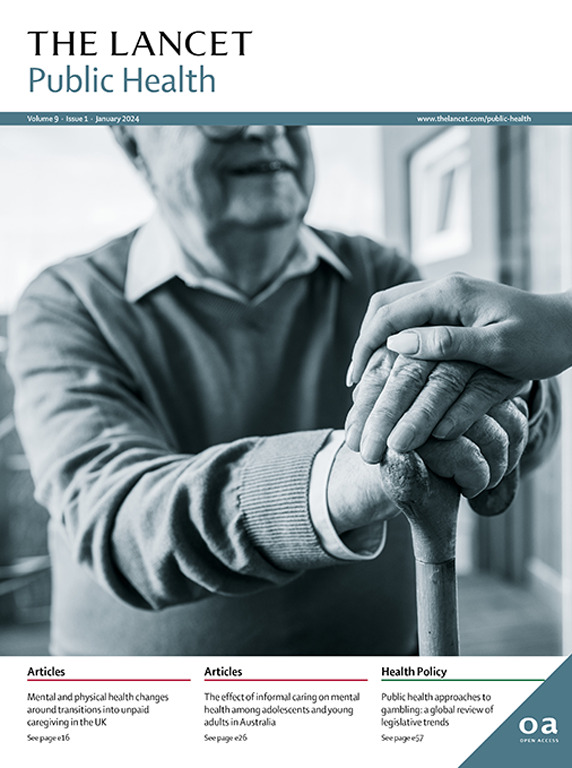2016 - 2022年中国5岁以下儿童死亡率流行病学变化:基于人群监测数据的观察性分析
IF 25.4
1区 医学
Q1 PUBLIC, ENVIRONMENTAL & OCCUPATIONAL HEALTH
引用次数: 0
摘要
可持续发展目标3.2旨在消除新生儿和5岁以下儿童可预防的死亡。中国在实现可持续发展目标3.2方面的进展尚未得到多维度评估。我们的目的是评估5岁以下儿童的死亡率(以下简称5岁以下儿童死亡率),并量化2016年至2022年中国可预防儿童死亡率和儿童死亡率的地理空间和时间趋势。方法利用2016年1月1日至2022年12月31日中国国家妇幼健康监测系统(MCHSS)的数据,分别对全国、农村和城市不同年龄段(0-6天、7-27天、0-27天、1 - 5个月、6-11个月、12-23个月、24-59个月和出生至59个月)的全因死亡率和病因特异性死亡率进行了分析。以及地区(中国东部、中部和西部)水平。使用低报率的3年移动平均值,按年龄组、居住类型、地区和地区居住阶层调整所有死亡率。根据《中国卫生统计年鉴》2016年至2022年的活产数估算全国死亡人数。根据2010年全国人口普查中生活在城市和农村地区的人口比例,对国家一级和区域一级的估计死亡率进行加权。新生儿和5岁以下儿童的最佳生存指标按2020 - 2022年的死亡原因计算(称为全国最佳),以六个地区居住阶层中观察到的最低死亡率为基础。研究发现,2022年,中国约有65 700 (95% CI 62 700 - 68 800)名5岁以下儿童死亡,其中45.1%(42.7 - 47.4%)的死亡发生在新生儿期(28天)。中国5岁以下儿童死亡率从2016年的每千活产10.2例(9.9 - 10.5例)下降到2022年的每千活产6.8例(6.5 - 7.2例);新生儿死亡率从2016年的每千活产4.9例(4.7 - 5.1例)下降到2022年的每千活产3.1例(2.9 - 3.3例)。农村5岁以下儿童相对死亡危险度由2016年的2.4(2.2 - 2·6)降至2022年的1.9(1.7 - 2.1),西部地区与东部地区相对死亡危险度由2016年的3.4(3.0 - 3.9)降至2022年的2.3(1.9 - 2.8)。2022年5岁以下儿童死亡的主要原因是伤害(占全因死亡的23.1%[21.1 - 25.1])、先天性畸形(14.8%[13.1 - 16.4])、早产并发症(14.1%[12.5 - 15.7])、产时相关事件(10.1%[8.7 - 11.5])和急性呼吸道感染(9.5%[8.2 - 10.9])。新生儿期死亡的主要原因是早产并发症(占5岁以下儿童死亡的12.8%[11.4 - 14.2])。2016年至2022年,中国5岁以下儿童死亡率有所下降。随着时间的推移,地区之间以及城乡之间的差距逐渐缩小,但仍然存在。因此,应努力进一步降低中国的儿童死亡率,包括持续的投资和政策、规划和干预措施的实施,特别是在西部农村地区。本文章由计算机程序翻译,如有差异,请以英文原文为准。
Changes in the epidemiology of under-5 mortality in China from 2016 to 2022: an observational analysis of population-based surveillance data
Background
Sustainable Development Goal (SDG) 3.2 aims to end preventable deaths of newborns and children younger than 5 years. China's progress towards SDG 3.2 has not been evaluated on multiple dimensions. We aimed to assess mortality rates in children younger than 5 years (hereafter referred to as under-5 mortality) and to quantify preventable child mortality and geospatial and temporal trends in child mortality in China from 2016 to 2022.Methods
In this observational analysis, we used data from the Chinese National Maternal and Child Health Surveillance System (MCHSS) for the period Jan 1, 2016, to Dec 31, 2022 and conducted all-cause mortality and cause-specific mortality analyses for different age groups (age 0–6 days, 7–27 days, 0–27 days, 1–5 months, 6–11 months, 12–23 months, 24–59 months, and birth to 59 months) separately at the national, residential (rural vs urban), and regional (eastern vs central vs western China) levels. All mortality rates were adjusted by age group, type of residency, region, and region-residency strata using a 3-year moving average of the under-reporting rates. National deaths were estimated using the number of livebirths from 2016 to 2022 from the Health Statistics Yearbook of China. Estimated national-level and regional-level mortality rates were weighted by the proportion of the population living in urban and rural areas from the 2010 national census. Optimal survival metrics for neonates and children younger than 5 years were calculated by cause of death in 2020–22 (termed the national optimum), on the basis of the lowest mortality observed among the six region-residency strata.Findings
In 2022, approximately 65 700 (95% CI 62 700–68 800) children younger than 5 years died in China, with 45·1% (42·7–47·4) of these deaths occurring in the neonatal period (age <28 days). China's under-5 mortality rate decreased from 10·2 deaths (9·9–10·5) per 1000 livebirths in 2016 to 6·8 deaths (6·5–7·2) per 1000 livebirths in 2022; the neonatal mortality rate decreased from 4·9 deaths (4·7–5·1) per 1000 livebirths in 2016 to 3·1 deaths (2·9–3·3) per 1000 livebirths in 2022. The relative risk of death in children younger than 5 years in rural areas compared with urban areas decreased from 2·4 (2·2–2·6) in 2016 to 1·9 (1·7–2·1) in 2022, and in the western region compared with the eastern region decreased from 3·4 (3·0–3·9) in 2016 to 2·3 (1·9–2·8) in 2022. The leading causes of under-5 mortality in 2022 were injuries (23·1% [21·1–25·1] of all-cause deaths), congenital malformations (14·8% [13·1–16·4]), preterm birth complications (14·1% [12·5–15·7]), intrapartum-related events (10·1% [8·7–11·5]), and acute respiratory infections (9·5% [8·2–10·9]). The leading cause of death in the neonatal period was preterm birth complications (12·8% [11·4–14·2] of deaths in children younger than 5 years).Interpretation
Under-5 mortality in China declined between 2016 and 2022. Disparities across regions and in urban versus rural areas narrowed over time, but they still exist. Therefore, efforts should be made to further reduce child mortality in China, including consistent investments and implementing of policies, programmes, and interventions, especially for the western rural areas.Funding
None.Translation
For the Chinese translation of the abstract see Supplementary Materials section.求助全文
通过发布文献求助,成功后即可免费获取论文全文。
去求助
来源期刊

Lancet Public Health
Medicine-Public Health, Environmental and Occupational Health
CiteScore
55.60
自引率
0.80%
发文量
305
审稿时长
8 weeks
期刊介绍:
The Lancet Public Health is committed to tackling the most pressing issues across all aspects of public health. We have a strong commitment to using science to improve health equity and social justice. In line with the values and vision of The Lancet, we take a broad and inclusive approach to public health and are interested in interdisciplinary research.
We publish a range of content types that can advance public health policies and outcomes. These include Articles, Review, Comment, and Correspondence. Learn more about the types of papers we publish.
 求助内容:
求助内容: 应助结果提醒方式:
应助结果提醒方式:


